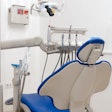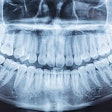Dental patients with a high caries risk are prevalent for a variety of reasons. Some examples include diet, oral hygiene, and xerostomia relating to polypharmacy. The most important way of treating these types of patients is to focus on prevention.
Fortunately, there are many different options to help combat caries in patients who are at high risk for decay. It is common knowledge that sweets and carbohydrates can lead to decay, so reducing these food items will help.
 Dr. Alexis Lee.
Dr. Alexis Lee.
What is less commonly known is that constant snacking leads to a lower pH, or more acidic, environment in the mouth. At a pH of 5.5 or below, the enamel and dentin demineralize, therefore making the teeth more susceptible to decay. It is advised to take breaks between meals and snacks to allow the pH of the mouth to return to a more neutral state. Simply drinking water or rinsing can help speed up this process.
Oral hygiene is also very important, especially for those patients who may be physically or mentally disabled. They may need adaptive toothbrushes that are easier to wield or possibly assistance from a caregiver. With these patients, it is also common for them to have food pocketing, especially in the upper posterior buccal areas. Therefore, it is important to ensure these areas are cleaned out after eating.
In geriatric patients, polypharmacy is almost always at play. Most medications have dry mouth, known as xerostomia, as a side effect, which greatly increases caries risk. Saliva has enzymes that can ward off bacteria and other pathogens in the mouth. So, patients with xerostomia may harbor more harmful bacteria that can lead to tooth decay.
Some helpful methods to reduce dry mouth would be to continually sip water; use saliva substitutes; and use products containing xylitol, such as gum, mints, or lozenges. Additionally, Biotene has an extensive line of products to help with xerostomia. These include mouth rinses, sprays, gels, and lozenges. Having several different kinds of products allows patients to find one that works best for them.
There is also a product called MI (minimal intervention) paste that remineralizes teeth through minerals such as calcium and phosphate. As previously mentioned, when the mouth is in an acidic state, the teeth begin to demineralize. MI paste can be extremely helpful for remineralization, which makes the teeth less prone to caries. Patients should use MI paste by applying a small amount to all surfaces of the teeth at least twice a day, especially before bed, which is when the mouth often becomes the most dry.
Even with these intervention techniques to reduce caries risk, many patients will still develop decay, which eventually grows and becomes irreversible. There are a couple of restorative materials that are especially beneficial to work with in these situations.
One such material is resin-modified glass ionomer (RMGI), which can be used for restorative fillings in place of amalgam or composite resin. There are many advantages to using RMG, including quick setting time, superior bond when isolation is compromised, and the ability to release fluoride ions even after placement.
However, one negative aspect is that it may not be as aesthetic as traditional composite fillings, but in these situations, the function of the filling often outweighs the appearance. This makes RMGI an excellent choice for a restorative material in patients who have high caries risk.
Another dental material that can be used when decay is already present is silver diamine fluoride or SDF. SDF comes in a liquid form and can be applied to small carious lesions to halt the progression of decay. There is no need for preparation of the tooth with a bur and handpiece.
SDF is especially useful in nursing homes or for disabled patients who have limited access to a traditional dental office. The main disadvantage of using SDF is that it has the potential to permanently stain the carious lesions a dark color. Therefore, SDF may not be the best option for the facial surfaces of anterior teeth. It is recommended that patients sign a consent form acknowledging the possibility of staining before treatment with SDF.
Overall, high caries risk will continue to be an obstacle for many dental patients. Fortunately, many different materials and products are available to lower their caries risk.
As always, the key to prevention is consistency. It is understandable for patients to have trouble establishing a routine for their oral health, so it is important to maintain good communication and follow-ups to determine the best way these patients can successfully avoid cavities.
Dr. Alexis Lee is a San Francisco Bay Area native and is a graduate of the University of the Pacific Arthur A. Dugoni School of Dentistry. She also received her Bachelor of Arts degree in rhetoric from the University of California, Berkeley. Since becoming a dentist, Lee has never forgotten her love of reading and writing and is excited to incorporate dentistry into her journey of becoming an established author.
The comments and observations expressed herein do not necessarily reflect the opinions of DrBicuspid.com, nor should they be construed as an endorsement or admonishment of any particular idea, vendor, or organization.



















